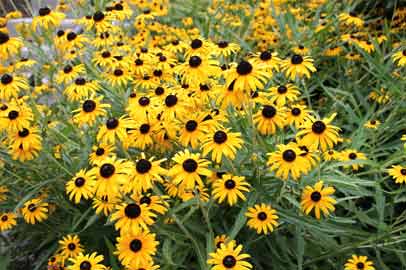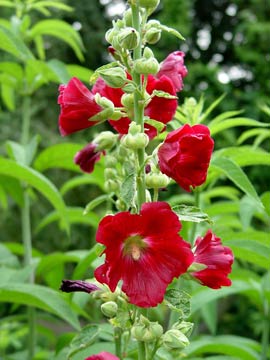If you’ve ever been to a garden center you may have noticed plants are divided into separate sections for “annuals” and “perennials”. These terms are important to pay attention to because they are used to categorize the life expectancy of different plants.
Annuals
 Nasturtiums are annual plants, completing their life cycle in one year.
Nasturtiums are annual plants, completing their life cycle in one year.
iStock/Thinkstock
So-called because these plants complete their life cycle in one year and then must start from seeds or cuttings the next year. Look for annuals near the beginning of the frost-free planting season. Some examples of annuals are marigolds, larkspur, nasturtium, cosmos, strawflowers, and zinnias.
Perennials
 Most types of Black-eyed Susans are perennial flowers in most of the United States.
Most types of Black-eyed Susans are perennial flowers in most of the United States.
George Weigel
These plants live for at least three years assuming wild animals and poor weather don’t kill them first. They will come back year after year from their own overwintering roots even though their foliage may die to the ground after frost. Perennials are sold throughout and often beyond the growing season. Examples include purple coneflowers, coreopsis, Black-eyed Susans, sedum, daylilies, asters, astilbe, phlox and goldenrod. A few perennials, known as “evergreen perennials” keep their leaves all winter in at least some climates. Examples include hellebores, yucca, candytuft, lavender, English ivy, pachysandra and some coral bells.
Biennials
 Hollyhocks are an example of biennials.
Hollyhocks are an example of biennials.
George Weigel
This third, lesser-known category is for plants that have a two-year life cycle. Biennial plants grow leaves, stems and roots the first year, then go dormant for the winter. In the second year the plant will flower and produce seeds before dying. Biennials are usually sold with perennials and include sweet william, foxglove, money plant and hollyhock. They may perform like perennials in the garden because new plants that emerge from seed constantly replace plants that have died after their second year. Vegetables like spinach, fennel, and lettuce are biennials, typically “bolting” and making them inedible the next year. Bolting is a survival mechanism that is triggered when the temperature begins to rise beyond what the plant can survive. At this point plants will focus all their energy on seed/flower production, abandoning leaf growth, to ensure the survival of the next generation.
Location is Key
Although these classifications may sound straightforward there are a few exceptions. These curveballs occur when the life cycle of a plant is altered due to the region it is being grown. For example, lantana, a trailing bloomer, grows like an annual in Northern states -it does well in the summer and then dies when freezing nights begin in the fall. However, that same plant can be categorized as a perennial in Southern states where it is warmer and frost is rare; in these regions lantana can live and bloom for years!
 Lantana is an example of a flower that can be an annual or a perennial, depending on where you’re trying to grow it.
Lantana is an example of a flower that can be an annual or a perennial, depending on where you’re trying to grow it.
iStock/Thinkstock
Plants like lantana differ botanically from typical annuals like marigolds and fall into a subcategory called “tender perennials”. These plants merely act like annuals in cold climates, but in warm climates that do not get frost, could live for years. Other tender perennials (or “Northern annuals”) include begonias, petunias, coleus, geraniums, snapdragons, euphorbias, rosemary, dusty miller, viola and salvias. In the vegetable garden, tomatoes and peppers are technically tender perennials, not annuals.